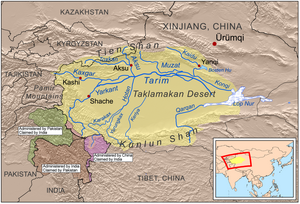Taklamakan

Taklamakan (तकला मकान), also known as Taklimakan and Teklimakan, is a desert in southwest Xinjiang Uyghur Autonomous Region, northwest China.
Location
It is bounded by the Kunlun Mountains to the south, the Pamir Mountains and Tian Shan (ancient Mount Imeon) to the west and north, and the Gobi Desert to the east.
Origin
The name may be an Areeb Uyghur borrowing of the Arabic tark, "to leave alone/out/behind, relinquish, abandon" + makan, "place".[1][2]
Another plausible explanation suggests it is derived from Turki taqlar makan, describing "the place of ruins".[3][4]
History
There is very little water in the Taklamakan Desert and it is hazardous to cross. Merchant caravans on the Silk Road would stop for relief at the thriving oasis towns.
It was in close proximity to many of the ancient civilizations—to the Northwest is the Amu Darya basin, to the southwest the Afghanistan mountain passes lead to Iran and India, to the east is China, and even to the north ancient towns like Almaty can be found.
The key oasis towns, watered by rainfall from the mountains, were Kashgar, Marin, Niya, Yarkand, and Khotan (Hetian) to the south, Kuqa and Turpan in the north, and Loulan and Dunhuang in the east.[5] Now, many, such as Marin and Gaochang, are ruined cities in sparsely inhabited areas in the Xinjiang Autonomous Region of the People's Republic of China.[6]
The archaeological treasures found in its sand-buried ruins point to Tocharian, early Hellenistic, Indian, and Buddhist influences. Its treasures and dangers have been vividly described by Aurel Stein, Sven Hedin, Albert von Le Coq, and Paul Pelliot.[7]
Mummies, some 4000 years old, have been found in the region.
Later, the Taklamakan was inhabited by Turkic peoples. Starting with the Tang Dynasty, the Chinese periodically extended their control to the oasis cities of the Taklamakan Desert in order to control the important silk route trade across Central Asia. Periods of Chinese rule were interspersed with rule by Turkic, Mongol and Tibetan peoples. The present population consists largely of Turkic Uyghur people.
External links
References
- ↑ E.M. Pospelov, Geograficheskiye nazvaniya mira (Moscow, 1998), p. 408.
- ↑ Gunnar Jarring,'The Toponym Takla-makan', Turkic Languages vol 1, 1997, pp 227-40.
- ↑ Tamm (2011), p. 139.
- ↑ "Takla Makan Desert at TravelChinaGuide.com"
- ↑ Ban, Paul G. The Atlas of World Archeology. New York: Check mark Books. pp. 134&n dash; 135. ISBN 0-8160-4051-6.
- ↑ The Silk Road: Trade, Travel, War and Faith
- ↑ Ban, Paul G. The Atlas of World Archeology. New York: Check mark Books. pp. 134&n dash; 135. ISBN 0-8160-4051-6.

